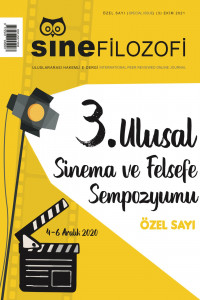Yeraltı ve Şarkı Söyleyen Kadınlar’da İtki İmgeler ve Kökensel Dünya Bağlamında İnsan-Dışı Hale Geliş
Inside and Singing Women Being Inhuman in the Context of Impulse Images and the Originary Worlds
Author(s): Özge Nilay Erbalaban GürbüzSubject(s): Semiotics / Semiology, Aesthetics, Contemporary Philosophy, Film / Cinema / Cinematography, Sociology of Art
Published by: Serdar Öztürk
Keywords: Impulse Images; Orginary Worlds; Inside; Singing Women; Gilles Deleuze;
Summary/Abstract: Art is one of the concepts has always discussed by philosophy from classical to modern. Whereas, philosophy re-exists in art, with the possibilities of art. In the works of Gilles Deleuze, one of the most authentic philosophers of the 20th Century, the artist and the philosopher are similar in terms of constructing ideas. However, the method of the artist and the method of the philosopher differentiate from one another. The artist creates ideas by activating perceptions and affections, while philosopher uses concepts. Director as an artist; expresses perceptions and affections in the form of images by using cinematic tools. This article aims to compare films from two auteur directors of New Turkish cinema, Inside (Zeki Demirkubuz, 2012) and Singing Women (Reha Erdem, 2013) with the image categories of Deleuze, and to demonstrate that these two directors use cinematic tools in their films to establish ideas through perceptions and affections, as emphasized by Deleuze. While conducting the research, first, the ideas about art in Deleuze’s philosophy were examined. For Deleuze, art is an activity of thought like philosophy and science. A chronological literature review shows that Deleuze’s philosophy cannot be separated from his thoughts on the philosophy of art, and that his ideas about cinema are an original part of this context. Then, the image classification that Deleuze discussed in Cinema I: Movement Image was mentioned in the context of “impulse images”. or Deleuze, the ability of films to perform a cinematic thinking activity depends on inventing images. The unifying concepts of impulse images are “the originary worlds” and “becoming”. For this reason, the mise-en-scène, acting and language signifiers in the aforementioned films have been analyzed through Deleuze’s impulse images and their unifying concepts. As a result, it was revealed that the directors cinematically constructed Deleuze’s images of impulse with the concepts that the philosopher discussed. It was concluded that the film directors discussed the categorical definition of mankind using signifiers such as mise-en-scène, acting and language.
Journal: SineFilozofi
- Issue Year: 6/2021
- Issue No: Sp. Iss.
- Page Range: 6-21
- Page Count: 16
- Language: Turkish

